Recording Urban Land Dynamic and Its Effects during 2000–2019 at 15-m Resolution by Cloud Computing with Landsat Series
Abstract
:1. Introduction
2. Materials and Methods
2.1. Study Area
2.2. Landsat Series and Pan-Sharpening in GEE
2.3. Integration of Automatic Thresholding and Multilevel Decision Rule Process
2.4. Data and Method for Accuracy Assessment
2.5. Land Dynamic Analysis
2.6. Quantifying Cause and Effect of Land Dynamics
3. Results
3.1. Accuray Report of Annual Maps
3.2. Land Dynamics in Changchun during 2000–2019
3.3. Quantified Correlation of Land Dynamics, Socio-Economic Development, and Environment Change
4. Discussion
4.1. Availability of Recording Urban Land Dynamics by Integrating Landsat, MDR, and GEE
4.2. Time-Series Land Dynamic for Understanding Urbanization in Changchun
4.3. Implication from Building the City of Garden in Changchun
5. Conclusions
Author Contributions
Funding
Acknowledgments
Conflicts of Interest
Appendix A
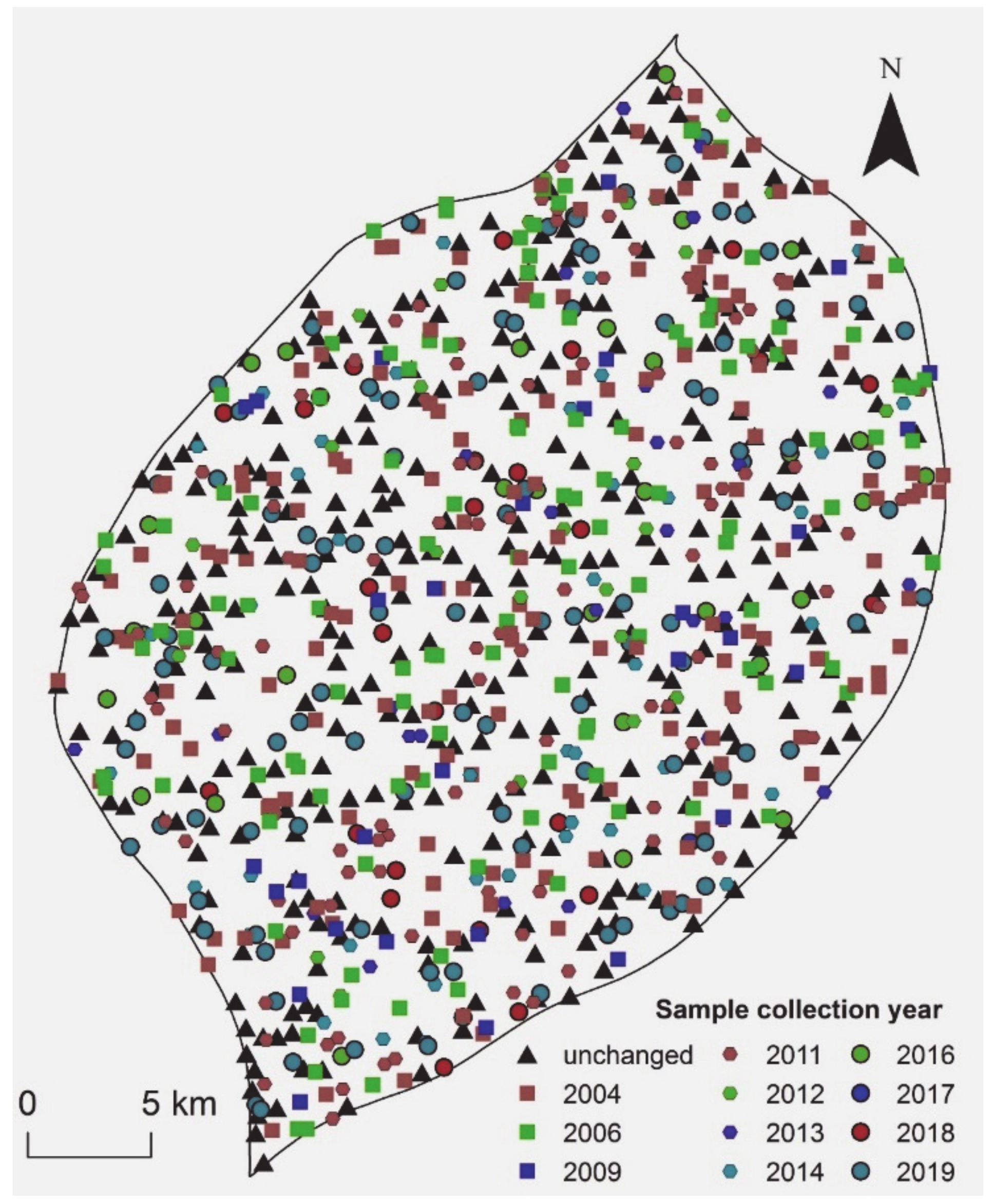

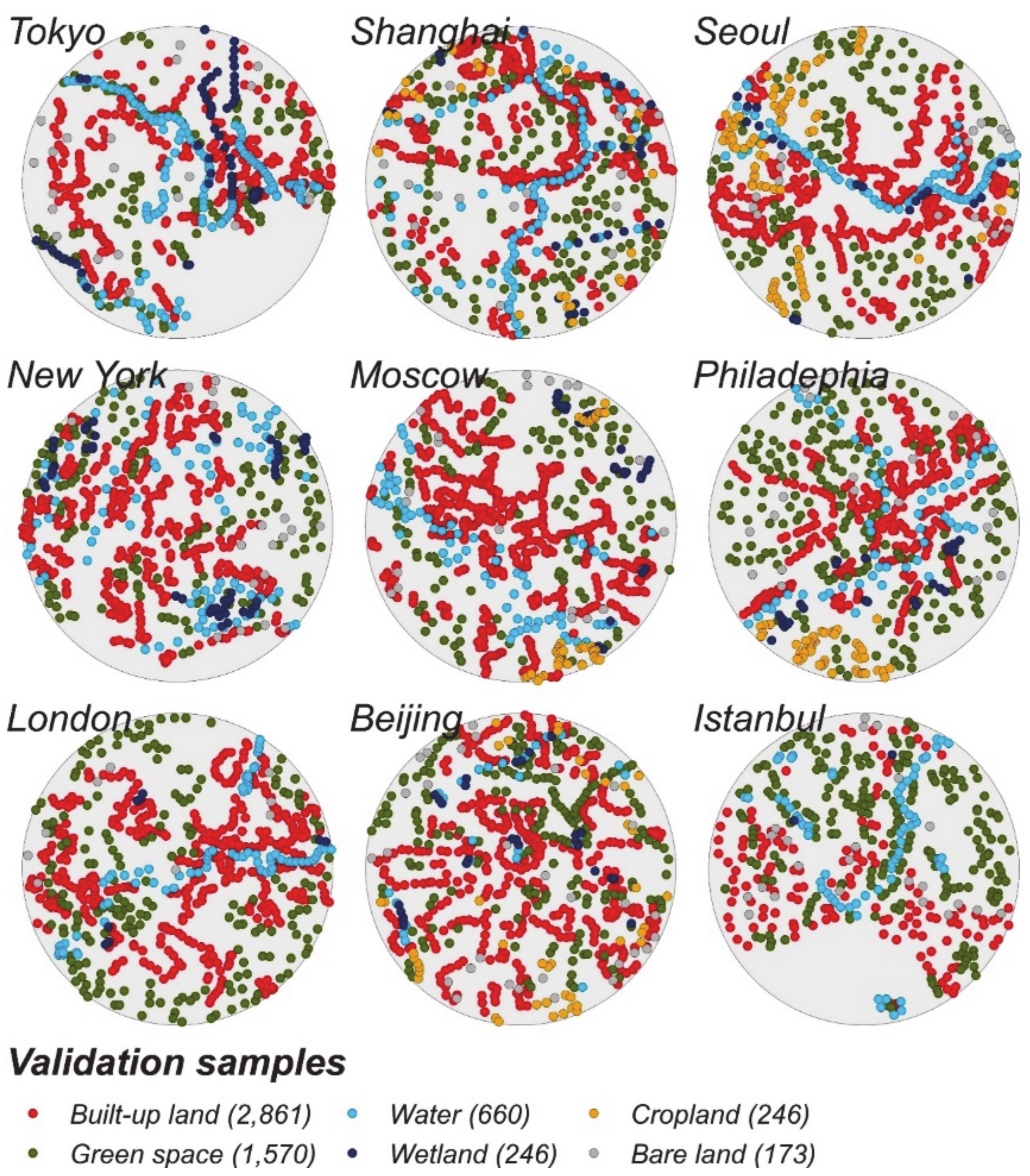
References
- Grimm, N.B.; Faeth, S.H.; Golubiewski, N.E.; Redman, C.L.; Wu, J.; Bai, X.; Briggs, J.M. Global change and the ecology of cities. Science 2008, 319, 756–760. [Google Scholar] [CrossRef] [PubMed] [Green Version]
- UN. World Urbanization Prospects: The 2018 Revision (ST/ESA/SER.A/420); United Nations: New York, NY, USA, 2019. [Google Scholar]
- Seto, K.C.; Ramankutty, N. Hidden linkages between urbanization and food systems. Science 2016, 352, 943–945. [Google Scholar] [CrossRef] [PubMed]
- Angel, S.; Parent, J.; Civco, D.L.; Blei, A.; Potere, D. The dimensions of global urban expansion: Estimates and projections for all countries, 2000–2050. Prog. Plann. 2011, 75, 53–107. [Google Scholar] [CrossRef]
- Rockstrom, J.; Steffen, W.; Noone, K.; Persson, A.; Chapin, F.S., III; Lambin, E.F.; Lenton, T.M.; Scheffer, M.; Folke, C.; Schellnhuber, H.J.; et al. A safe operating space for humanity. Nature 2009, 461, 472–475. [Google Scholar] [CrossRef] [PubMed]
- Liu, X.; Huang, Y.; Xu, X.; Li, X.; Li, X.; Ciais, P.; Lin, P.; Gong, K.; Ziegler, A.D.; Chen, A.; et al. High-spatiotemporal-resolution mapping of global urban change from 1985 to 2015. Nat. Sustain. 2020. [Google Scholar] [CrossRef]
- Van Vliet, J. Direct and indirect loss of natural area from urban expansion. Nat. Sustain. 2019, 2, 755–763. [Google Scholar] [CrossRef]
- Dou, Y.Y.; Kuang, W.H. A comparative analysis of urban impervious surface and green space and their dynamics among 318 different size cities in China in the past 25 years. Sci. Total Environ. 2020, 706, 135828. [Google Scholar] [CrossRef]
- Kuang, W. National urban land-use/cover change since the beginning of the 21st century and its policy implications in China. Land Use Policy 2020, 97, 104747. [Google Scholar] [CrossRef]
- Kuang, W.; Chi, W.; Lu, D.; Dou, Y. A comparative analysis of megacity expansions in China and the U.S.: Patterns, rates and driving forces. Landsc. Urban Plan. 2014, 132, 121–135. [Google Scholar] [CrossRef]
- Gong, P.; Li, X.; Wang, J.; Bai, Y.; Cheng, B.; Hu, T.; Liu, X.; Xu, B.; Yang, J.; Zhang, W.; et al. Annual maps of global artificial impervious area (GAIA) between 1985 and 2018. Remote Sens. Environ. 2020, 236, 111510. [Google Scholar] [CrossRef]
- Phiri, D.; Morgenroth, J. Developments in Landsat Land Cover Classification Methods: A Review. Remote Sens. 2017, 9, 967. [Google Scholar] [CrossRef] [Green Version]
- Zhong, Q.; Ma, J.; Zhao, B.; Wang, X.; Zong, J.; Xiao, X. Assessing spatial-temporal dynamics of urban expansion, vegetation greenness and photosynthesis in megacity Shanghai, China during 2000–2016. Remote Sens. Environ. 2019, 233, 111374. [Google Scholar] [CrossRef]
- Zhao, Y.; Feng, D.; Yu, L.; Cheng, Y.; Zhang, M.; Liu, X.; Xu, Y.; Fang, L.; Zhu, Z.; Gong, P. Long-Term Land Cover Dynamics (1986–2016) of Northeast China Derived from a Multi-Temporal Landsat Archive. Remote Sens. 2019, 11, 599. [Google Scholar] [CrossRef] [Green Version]
- Reba, M.; Seto, K.C. A systematic review and assessment of algorithms to detect, characterize, and monitor urban land change. Remote Sens. Environ. 2020, 242, 111739. [Google Scholar] [CrossRef]
- Ren, Z.; He, X.; Zheng, H.; Zhang, D.; Yu, X.; Shen, G.; Guo, R. Estimation of the Relationship between Urban Park Characteristics and Park Cool Island Intensity by Remote Sensing Data and Field Measurement. Forests 2013, 4, 868–886. [Google Scholar] [CrossRef] [Green Version]
- Ren, Z.; Zheng, H.; He, X.; Zhang, D.; Shen, G.; Zhai, C. Changes in spatio-temporal patterns of urban forest and its above-ground carbon storage: Implication for urban CO2 emissions mitigation under China’s rapid urban expansion and greening. Environ. Int. 2019, 129, 438–450. [Google Scholar] [CrossRef]
- Fang, D.; Wang, Q.; Li, H.; Yu, Y.; Lu, Y.; Qian, X. Mortality effects assessment of ambient PM2.5 pollution in the 74 leading cities of China. Sci. Total Environ. 2016, 569, 1545–1552. [Google Scholar] [CrossRef]
- Qiu, B.; Li, H.; Tang, Z.; Chen, C.; Berry, J. How cropland losses shaped by unbalanced urbanization process? Land Use Policy 2020, 96, 104715. [Google Scholar] [CrossRef]
- He, C.; Liu, Z.; Xu, M.; Ma, Q.; Dou, Y. Urban expansion brought stress to food security in China: Evidence from decreased cropland net primary productivity. Sci. Total Environ. 2017, 576, 660–670. [Google Scholar] [CrossRef]
- Zhou, W.Q.; Wang, J.; Qian, Y.G.; Pickett, S.T.A.; Li, W.F.; Han, L.J. The rapid but "invisible" changes in urban greenspace: A comparative study of nine Chinese cities. Sci. Total Environ. 2018, 627, 1572–1584. [Google Scholar] [CrossRef]
- Gorelick, N.; Hancher, M.; Dixon, M.; Ilyushchenko, S.; Thau, D.; Moore, R. Google Earth Engine: Planetary-scale geospatial analysis for everyone. Remote Sens. Environ. 2017, 202, 18–27. [Google Scholar] [CrossRef]
- Donchyts, G.; Baart, F.; Winsemius, H.; Gorelick, N.; Kwadijk, J.; van de Giesen, N. Earth’s surface water change over the past 30 years. Nat. Clim. Chang. 2016, 6, 810–813. [Google Scholar] [CrossRef]
- Dong, J.; Xiao, X.; Menarguez, M.A.; Zhang, G.; Qin, Y.; Thau, D.; Biradar, C.; Moore, B., III. Mapping paddy rice planting area in northeastern Asia with Landsat 8 images, phenology-based algorithm and Google Earth Engine. Remote Sens. Environ. 2016, 185, 142–154. [Google Scholar] [CrossRef] [PubMed] [Green Version]
- Gong, P.; Liu, H.; Zhang, M.; Li, C.; Wang, J.; Huang, H.; Clinton, N.; Ji, L.; Li, W.; Bai, Y.; et al. Stable classification with limited sample: Transferring a 30-m resolution sample set collected in 2015 to mapping 10-m resolution global land cover in 2017. Sci. Bull. 2019, 64, 370–373. [Google Scholar] [CrossRef] [Green Version]
- Pan, T.; Kuang, W.; Hamdi, R.; Zhang, C.; Zhang, S.; Li, Z.; Chen, X. City-Level Comparison of Urban Land-Cover Configurations from 2000-2015 across 65 Countries within the Global Belt and Road. Remote Sens. 2019, 11, 1515. [Google Scholar] [CrossRef] [Green Version]
- Gilbertson, J.K.; Kemp, J.; van Niekerk, A. Effect of pan-sharpening multi-temporal Landsat 8 imagery for crop type differentiation using different classification techniques. Comput. Electron. Agric. 2017, 134, 151–159. [Google Scholar] [CrossRef] [Green Version]
- Meng, X.; Shen, H.; Li, H.; Zhang, L.; Fu, R. Review of the pansharpening methods for remote sensing images based on the idea of meta-analysis: Practical discussion and challenges. Inf. Fusion 2019, 46, 102–113. [Google Scholar] [CrossRef]
- Google. Spectral Transformations. Available online: https://developers.google.com/earth-engine/image_transforms (accessed on 21 May 2020).
- Chen, L.; Ren, C.; Zhang, B.; Wang, Z.; Liu, M. Quantifying Urban Land Sprawl and its Driving Forces in Northeast China from 1990 to 2015. Sustainability 2018, 10, 188. [Google Scholar] [CrossRef] [Green Version]
- Kuang, W.; Yan, F. Urban structural evolution over a century in Changchun city, Northeast China. J. Geogr. Sci. 2018, 28, 1877–1895. [Google Scholar]
- Li, G.Y.; Li, L.W.; Lu, D.S.; Guo, W.; Kuang, W.H. Mapping impervious surface distribution in China using multi-source remotely sensed data. GISci. Remote Sens. 2020, 57, 543–552. [Google Scholar] [CrossRef]
- Roy, D.P.; Kovalskyy, V.; Zhang, H.K.; Vermote, E.F.; Yan, L.; Kumar, S.S.; Egorov, A. Characterization of Landsat-7 to Landsat-8 reflective wavelength and normalized difference vegetation index continuity. Remote Sens. Environ. 2016, 185, 57–70. [Google Scholar] [CrossRef] [PubMed] [Green Version]
- Mao, D.; He, X.; Wang, Z.; Tian, Y.; Xiang, H.; Yu, H.; Man, W.; Jia, M.; Ren, C.; Zheng, H. Diverse policies leading to contrasting impacts on land cover and ecosystem services in Northeast China. J. Clean. Prod. 2019, 240, 117961. [Google Scholar] [CrossRef]
- Sun, Y.; Zhao, S.; Qu, W. Quantifying spatiotemporal patterns of urban expansion in three capital cities in Northeast China over the past three decades using satellite data sets. Environ. Earth Sci. 2015, 73, 7221–7235. [Google Scholar] [CrossRef]
- Li, X.; Gong, P. An "exclusion-inclusion" framework for extracting human settlements in rapidly developing regions of China from Landsat images. Remote Sens. Environ. 2016, 186, 286–296. [Google Scholar] [CrossRef]
- Dong, Y.; Ren, Z.; Wang, Z.; Yu, Q.; Zhu, L.; Yu, H.; Bao, G. Spatiotemporal Patterns of Forest Changes in Korean Peninsula Using Landsat Images During 1990–2015: A Comparative Study of Two Neighboring Countries. IEEE Access 2020, 8, 73623–73633. [Google Scholar] [CrossRef]
- Zhang, L.; Li, X.; Yuan, Q.; Liu, Y. Object-based approach to national land cover mapping using HJ satellite imagery. J. Appl. Remote Sens. 2014, 8, 083686. [Google Scholar] [CrossRef]
- Xue, Z.; Hou, G.; Zhang, Z.; Lyu, X.; Jiang, M.; Zou, Y.; Shen, X.; Wang, J.; Liu, X. Quantifying the cooling-effects of urban and peri-urban wetlands using remote sensing data: Case study of cities of Northeast China. Landsc. Urban Plan. 2019, 182, 92–100. [Google Scholar] [CrossRef]
- Otsu, N. Threshold Selection Method from Gray-Level Histograms. IEEE Trans. Syst. Man. Cybern. 1979, 9, 62–66. [Google Scholar] [CrossRef] [Green Version]
- Venkatappa, M.; Sasaki, N.; Shrestha, R.P.; Tripathi, N.K.; Ma, H.-O. Determination of Vegetation Thresholds for Assessing Land Use and Land Use Changes in Cambodia Using the Google Earth Engine Cloud-Computing Platform. Remote Sens. 2019, 11, 1514. [Google Scholar] [CrossRef] [Green Version]
- Li, X.; Zhou, Y.; Asrar, G.R.; Meng, L. Characterizing spatiotemporal dynamics in phenology of urban ecosystems based on Landsat data. Sci. Total Environ. 2017, 605, 721–734. [Google Scholar] [CrossRef]
- Olofsson, P.; Foody, G.M.; Herold, M.; Stehman, S.V.; Woodcock, C.E.; Wulder, M.A. Good practices for estimating area and assessing accuracy of land change. Remote Sens. Environ. 2014, 148, 42–57. [Google Scholar] [CrossRef]
- Pettitt, A.N. A Non-Parametric Approach to the Change-Point Problem. J. R. Stat. Soc. Ser. C (Appl. Stat.) 1979, 28, 126–135. [Google Scholar] [CrossRef]
- Verstraeten, G.; Poesen, J.; Demarée, G.; Salles, C. Long-term (105 years) variability in rain erosivity as derived from 10-min rainfall depth data for Ukkel (Brussels, Belgium): Implications for assessing soil erosion rates. J. Geophys. Res. Atmos. 2006, 111. [Google Scholar] [CrossRef]
- Van Donkelaar, A.; Martin, R.V.; Brauer, M.; Hsu, N.C.; Kahn, R.A.; Levy, R.C.; Lyapustin, A.; Sayer, A.M.; Winker, D.M. Global Estimates of Fine Particulate Matter using a Combined Geophysical-Statistical Method with Information from Satellites, Models, and Monitors. Environ. Sci. Technol. 2016, 50, 3762–3772. [Google Scholar] [CrossRef]
- Maxwell, A.E.; Warner, T.A.; Fang, F. Implementation of machine-learning classification in remote sensing: An applied review. Int. J. Remote Sens. 2018, 39, 2784–2817. [Google Scholar] [CrossRef] [Green Version]
- Tropek, R.; Sedlacek, O.; Beck, J.; Keil, P.; Musilova, Z.; Simova, I.; Storch, D. Comment on “High-resolution global maps of 21st-century forest cover change”. Science 2014, 344. [Google Scholar] [CrossRef] [Green Version]
- Zhao, S.; Zhou, D.; Zhu, C.; Sun, Y.; Wu, W.; Liu, S. Spatial and Temporal Dimensions of Urban Expansion in China. Environ. Sci. Technol. 2015, 49, 9600–9609. [Google Scholar] [CrossRef]

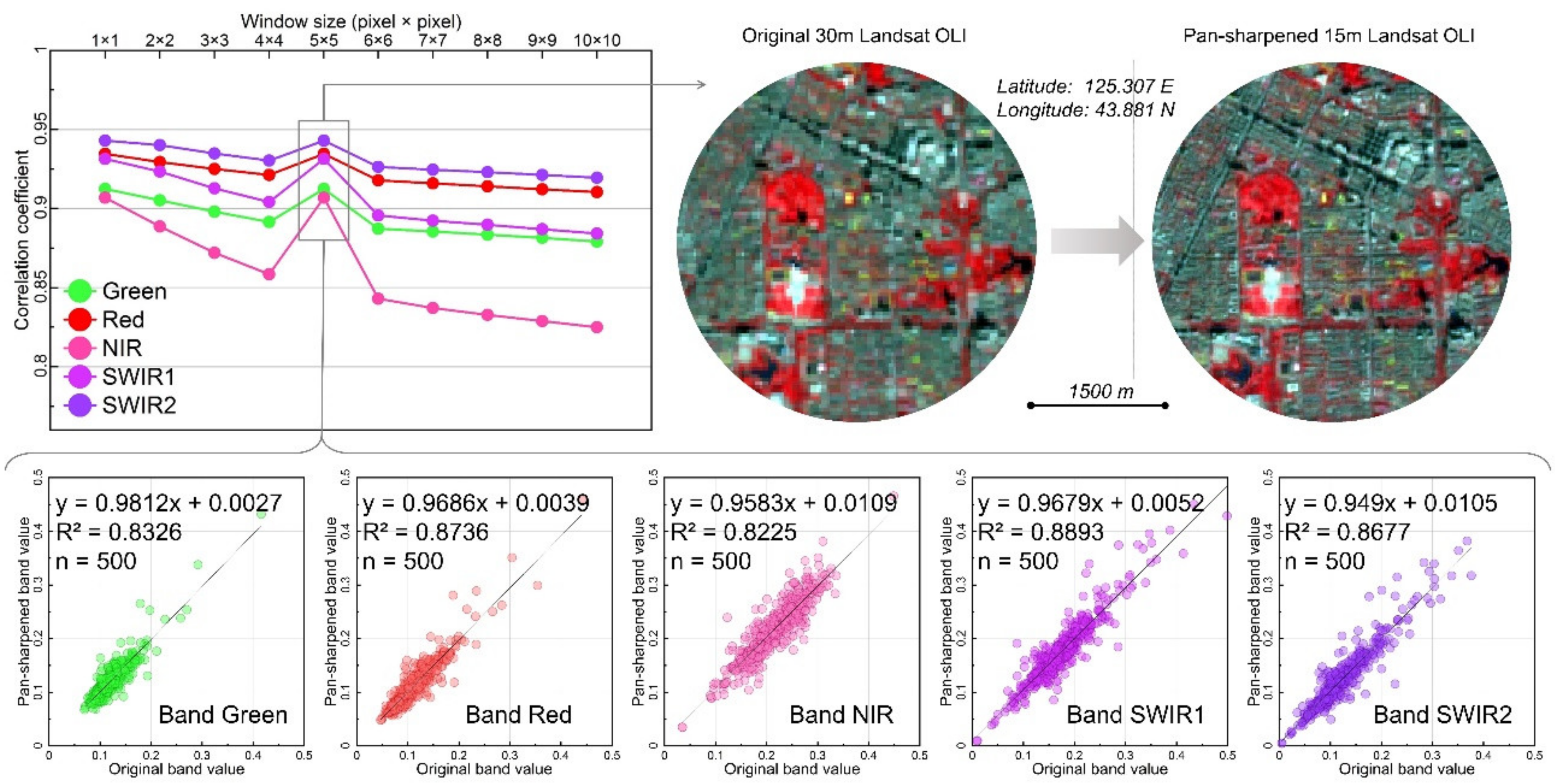


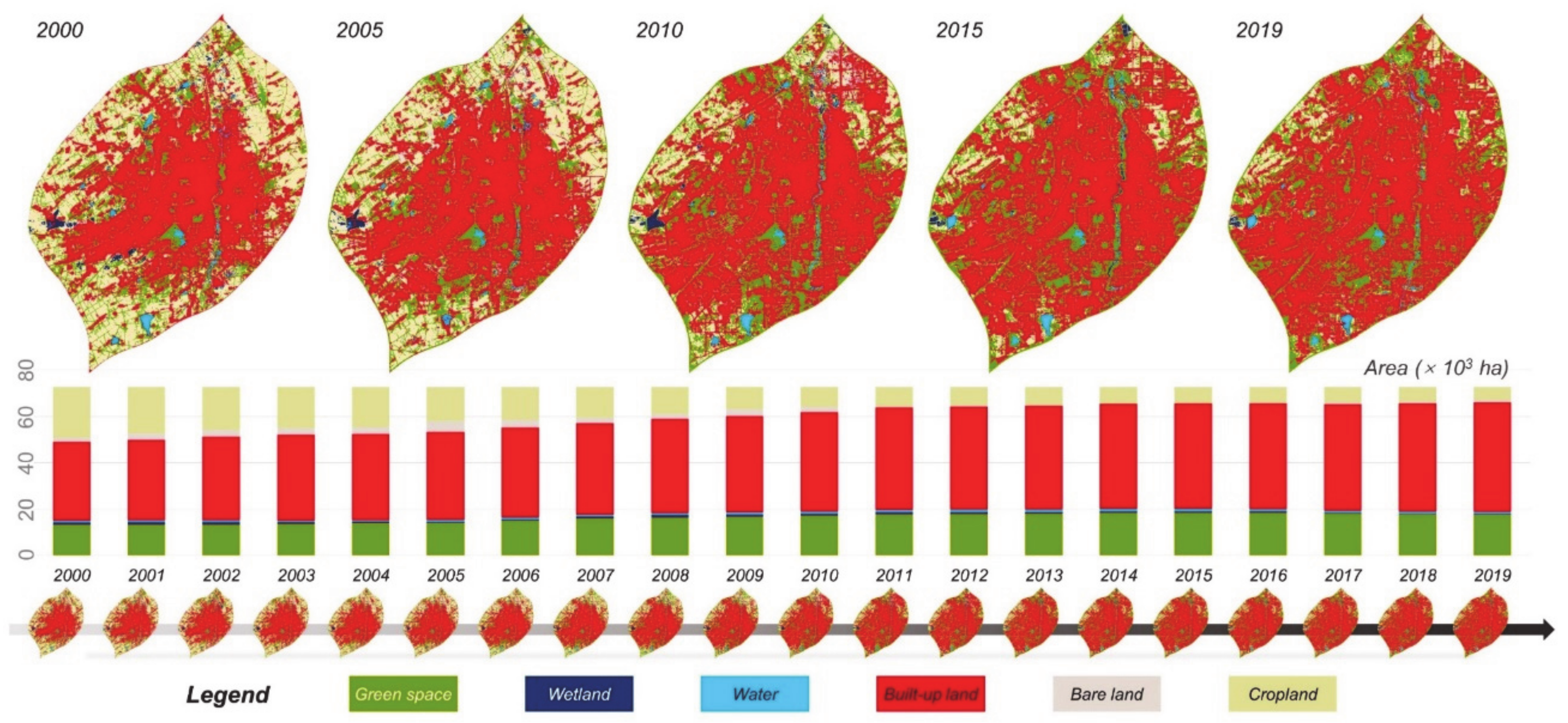
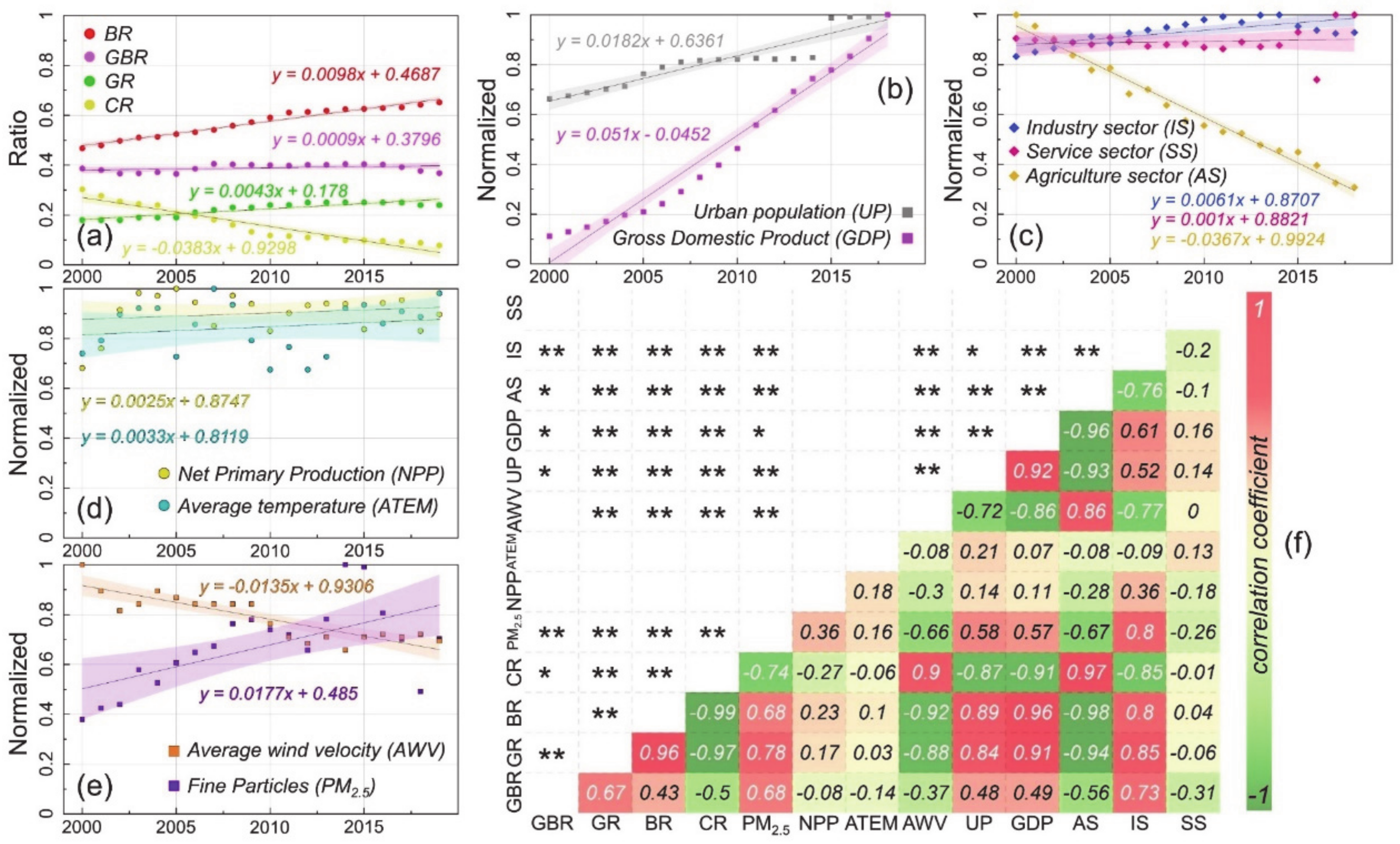
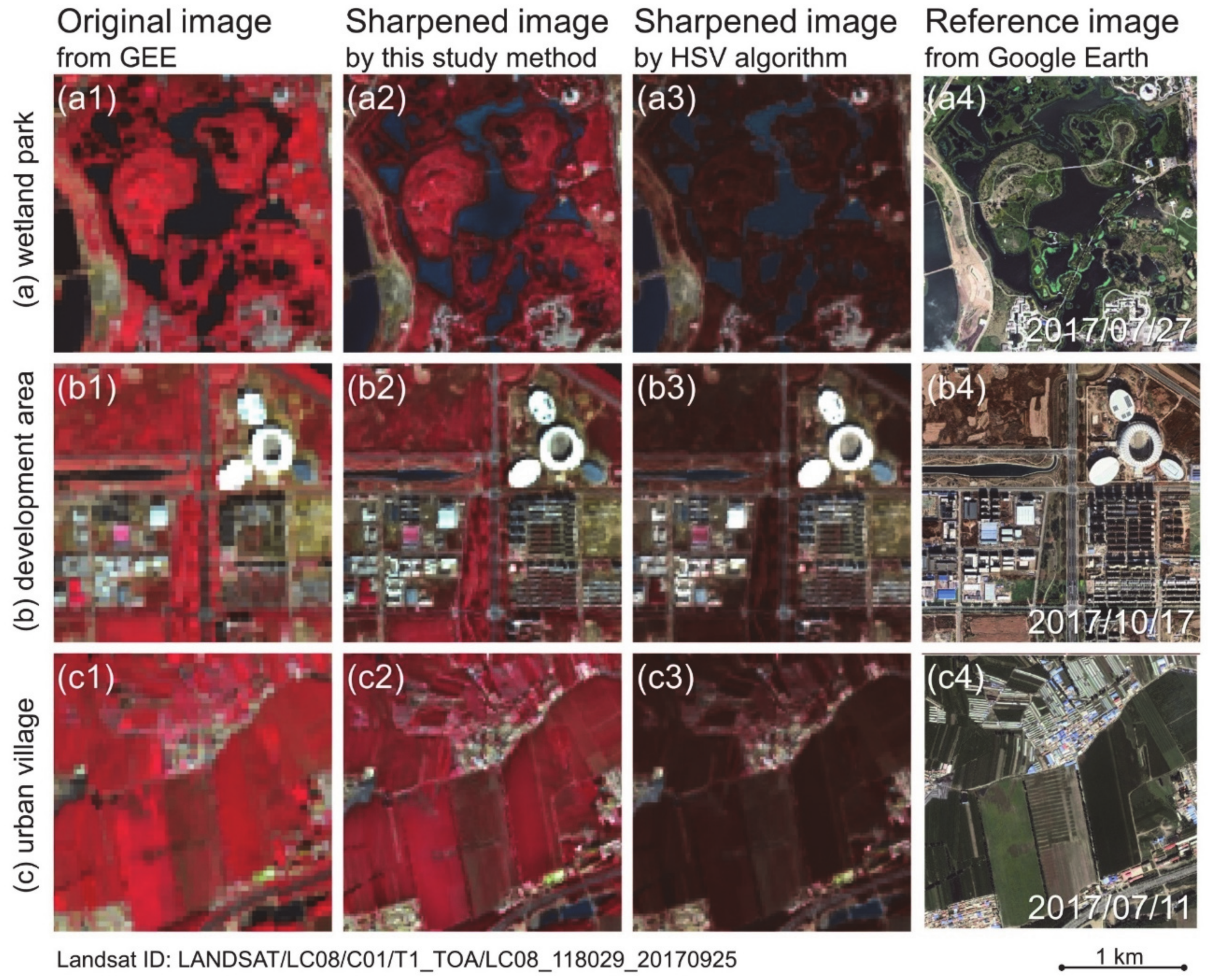
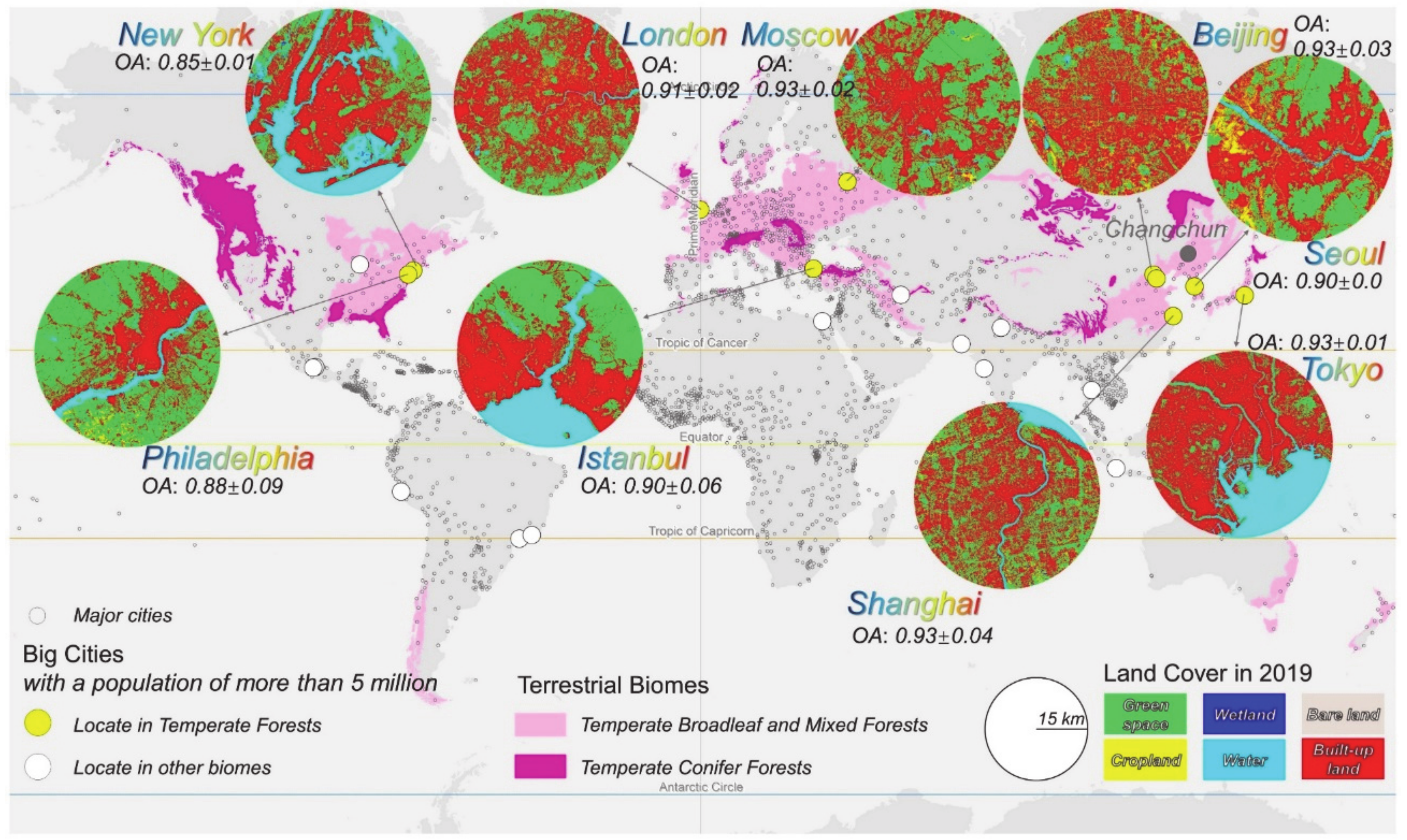

| Sensor | Period | Band | Annual Composite | Panchromatic Source |
|---|---|---|---|---|
| TM | 2000–2012 | G, R, NIR, SWIR1, SWIR2, LST | Yes | No |
| ETM+ | 2000–2019 | G, R, NIR, SWIR1, SWIR2, LST, Pan | Yes | Yes |
| OLI | 2013–2019 | Yes | Yes |
| Code | Category | Brief Description |
|---|---|---|
| 10 | Green space | Natural or artificial vegetated land includes forest, shrub, grass, etc. |
| 20 | Wetland | Water environment in which herbs seasonally grows. |
| 30 | Water | Natural or artificial lake, channel, pond, etc. |
| 40 | Built-up land | Artificial infrastructure for living, transport, production, etc. |
| 50 | Bare land | Abandoned, cleared, or in-planning urban space. |
| 60 | Cropland | Regular shaped arable land for grain growing. |
| Item | Year | |||||||||||
|---|---|---|---|---|---|---|---|---|---|---|---|---|
| 2004 | 2006 | 2009 | 2011 | 2012 | 2013 | 2014 | 2016 | 2017 | 2018 | 2019 | ||
| GS | PA | 0.82 ± 0.06 | 0.86 ± 0.06 | 0.94 ± 0.05 | 0.99 ± 0.03 | 0.94 ± 0.06 | 0.94 ± 0.06 | 0.9 ± 0.03 | 0.96 ± 0.04 | 0.93 ± 0.03 | 0.91 ± 0.02 | 0.95 ± 0.03 |
| UA | 0.86 ± 0.06 | 0.91 ± 0.06 | 0.92 ± 0.05 | 0.98 ± 0.03 | 0.85 ± 0.06 | 0.84 ± 0.06 | 0.97 ± 0.03 | 0.93 ± 0.04 | 0.95 ± 0.04 | 0.98 ± 0.02 | 0.97 ± 0.03 | |
| WL | PA | 0.63 ± 0.01 | 0.78 ± 0.01 | 0.96 ± 0.01 | 0.79 ± 0.01 | 0.91 ± 0.01 | 0.9 ± 0.01 | 0.86 ± 0.01 | 0.89 ± 0.01 | 0.84 ± 0.01 | 0.86 ± 0.01 | 0.9 ± 0.01 |
| UA | 0.85 ± 0.2 | 0.67 ± 0.41 | 0.85 ± 0.2 | 0.96 ± 0.09 | 0.96 ± 0.09 | 0.92 ± 0.11 | 0.71 ± 0.36 | 0.83 ± 0.33 | 0.73 ± 0.28 | 0.8 ± 0.39 | 0.9 ± 0.13 | |
| WA | PA | 0.85 ± 0.14 | 0.87 ± 0.39 | 0.84 ± 0.18 | 0.79 ± 0.27 | 0.96 ± 0.3 | 0.81 ± 0.3 | 0.78 ± 0.31 | 0.79 ± 0.23 | 0.95 ± 0.26 | 0.91 ± 0.22 | 0.96 ± 0.13 |
| UA | 0.91 ± 0.12 | 0.75 ± 0.32 | 0.84 ± 0.15 | 0.75 ± 0.22 | 0.71 ± 0.25 | 0.59 ± 0.24 | 0.75 ± 0.26 | 0.86 ± 0.19 | 0.76 ± 0.21 | 0.83 ± 0.18 | 0.92 ± 0.11 | |
| BT | PA | 0.96 ± 0.04 | 0.99 ± 0.06 | 0.97 ± 0.03 | 0.99 ± 0.03 | 0.97 ± 0.02 | 0.96 ± 0.02 | 0.96 ± 0.02 | 0.95 ± 0.02 | 0.95 ± 0.03 | 0.94 ± 0.01 | 0.95 ± 0.02 |
| UA | 0.97 ± 0.04 | 0.96 ± 0.03 | 0.98 ± 0.02 | 0.98 ± 0.02 | 0.99 ± 0.01 | 0.99 ± 0.01 | 0.99 ± 0.01 | 0.98 ± 0.01 | 0.98 ± 0.02 | 0.99 ± 0.01 | 0.99 ± 0.01 | |
| BL | PA | 0.8 ± 0.22 | 0.74 ± 0.28 | 0.83 ± 0.17 | 0.38 ± 0.15 | 0.61 ± 0.46 | 0.59 ± 0.52 | 0.3 ± 0.6 | 0.17 ± 0.3 | 0.52 ± 0.4 | 0.93 ± 0.01 | 0.68 ± 0.35 |
| UA | 0.71 ± 0.17 | 0.79 ± 0.22 | 0.88 ± 0.14 | 0.94 ± 0.12 | 0.5 ± 0.37 | 0.67 ± 0.41 | 0.6 ± 0.48 | 0.82 ± 0.24 | 0.75 ± 0.32 | 0.97 ± 0.01 | 0.86 ± 0.28 | |
| CL | PA | 0.93 ± 0.08 | 0.83 ± 0.09 | 0.79 ± 0.07 | 0.94 ± 0.04 | 0.79 ± 0.08 | 0.82 ± 0.09 | 0.85 ± 0.14 | 0.79 ± 0.07 | 0.79 ± 0.1 | 0.88 ± 0.17 | 0.84 ± 0.14 |
| UA | 0.87 ± 0.08 | 0.87 ± 0.09 | 0.9 ± 0.07 | 0.98 ± 0.04 | 0.89 ± 0.08 | 0.91 ± 0.09 | 0.74 ± 0.14 | 0.9 ± 0.07 | 0.84 ± 0.1 | 0.73 ± 0.17 | 0.85 ± 0.14 | |
| Overall accuracy | 0.92 ± 0.03 | 0.92 ± 0.04 | 0.95 ± 0.03 | 0.98 ± 0.02 | 0.94 ± 0.02 | 0.94 ± 0.02 | 0.95 ± 0.02 | 0.96 ± 0.02 | 0.95 ± 0.02 | 0.96 ± 0.02 | 0.97 ± 0.02 | |
| Category | Turning | ||
|---|---|---|---|
| Green space | 2009 ** | 2.66 | 0.43 |
| Wetland | 2012 | −3.39 | −9.45 |
| Water | 2009 ** | 1.25 | 0.69 |
| Built-up land | 2009 ** | 2.24 | 1.30 |
| Bare land | 2010 ** | 3.56 | −10.83 |
| Cropland | 2009 ** | −9.19 | −5.29 |
© 2020 by the authors. Licensee MDPI, Basel, Switzerland. This article is an open access article distributed under the terms and conditions of the Creative Commons Attribution (CC BY) license (http://creativecommons.org/licenses/by/4.0/).
Share and Cite
Dong, Y.; Ren, Z.; Fu, Y.; Miao, Z.; Yang, R.; Sun, Y.; He, X. Recording Urban Land Dynamic and Its Effects during 2000–2019 at 15-m Resolution by Cloud Computing with Landsat Series. Remote Sens. 2020, 12, 2451. https://doi.org/10.3390/rs12152451
Dong Y, Ren Z, Fu Y, Miao Z, Yang R, Sun Y, He X. Recording Urban Land Dynamic and Its Effects during 2000–2019 at 15-m Resolution by Cloud Computing with Landsat Series. Remote Sensing. 2020; 12(15):2451. https://doi.org/10.3390/rs12152451
Chicago/Turabian StyleDong, Yulin, Zhibin Ren, Yao Fu, Zhenghong Miao, Ran Yang, Yuanhe Sun, and Xingyuan He. 2020. "Recording Urban Land Dynamic and Its Effects during 2000–2019 at 15-m Resolution by Cloud Computing with Landsat Series" Remote Sensing 12, no. 15: 2451. https://doi.org/10.3390/rs12152451
APA StyleDong, Y., Ren, Z., Fu, Y., Miao, Z., Yang, R., Sun, Y., & He, X. (2020). Recording Urban Land Dynamic and Its Effects during 2000–2019 at 15-m Resolution by Cloud Computing with Landsat Series. Remote Sensing, 12(15), 2451. https://doi.org/10.3390/rs12152451





